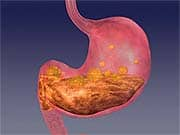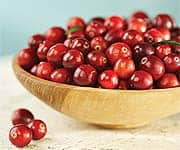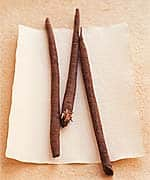Life Extension Magazine®
In their quest to promote a long and healthy life, many Americans forget one of the first links in the chain—their stomachs. The consequences of stomach neglect range from simple heartburn all the way to ulcers and even cancer. The pathological effects of alcohol, smoking, and stress, coupled with an epidemic rate of infection with the Helicobacter pylori 1-6 bacterium mean that all the ingredients are present for the “perfect storm” of stomach distress and disease. Fortunately, a “dynamic trio” of nutrients—zinc-carnosine, licorice extract, and cranberry—work in concert to protect stomach function from the rough players in the environment. These nutrients both relieve distress and also support the body’s natural defense mechanisms in preventing inflammation and the changes that can lead to cancer. A fourth stomach-protecting agent called picrorhiza protects the mucosa via additional mechanisms, and can now be included as part of a natural gastric health brigade. The StomachThe human stomach, even in the prime of health, is a tough neighborhood. Let’s take a quick tour of some of its most astonishing features, so that we can see why it’s so vulnerable to attack. The stomach’s extreme acidity provides a primary defense against infection and also assists in the first stages of digestion. Containing extreme levels of acidity, however, poses an intense biological challenge. Indeed, the fact that the stomach doesn’t self-destruct is one of life’s major miracles! A thick coating of protective mucus is steadily secreted by the specialized surface mucous cells in the organ’s lining, and a rapid turnover of cells in the lining itself keeps “fresh troops” always at hand. Nonetheless, it’s a delicately balanced system, and with that amount of firepower around, any breach in the defenses rapidly grows into a major problem.
Virtually everyone has experienced at least mild gastritis or “upset stomach” we associate with overindulgence and stress. While these are usually thought of as annoyances, each episode causes a bit more lasting damage, eventually resulting in cellular injury which in turn causes inflammation.7 The inflammation then produces free radicals that go on to create still more tissue destruction,8,9 eventually damaging DNA and potentially leading to cancers of the stomach, which are among the most lethal malignancies known.6 Infection with the H. pylori bacterium produces all these effects and more. In fact, it is now recognized as a major cause of stomach and upper intestinal disorders, including ulcers of the stomach and duodenum (beginning of the small intestine), gastric cancers, and gastritis.10,11 After the organism sets up shop in the stomach lining (it has elaborate defense mechanisms that allow it to survive the acid), H. pylori produces an influx of inflammatory cells by secreting powerful “virulence factors.”10, In a microscopic “one-two punch,”12 these bacterial proteins block normal function of certain immune cells, while boosting the free radical production from others,13,14 and stimulating still another group of immune cells to produce inflammatory cytokines, the messengers that call new inflammatory cells into the region.10 The discovery that H. pylori infection and inflammation lead to gastritis and ulcers was one of the major breakthroughs in modern medical science15,16 (two scientists won the Nobel prize for this discovery). The finding that eradication of the organism can relieve symptoms and prevent cancer is perhaps even more meaningful.17 While antibiotic treatment can be effective against H. pylori, there’s powerful evidence for the role of specific nutrients in alleviating the misery caused by this bacterial nemesis.18,19 Nutritional Approaches to Maintaining Stomach HealthNatural substances have been used around the world for millennia to promote stomach health.20 Modern science is catching up, however, as scientists are finding that certain of these “folk remedies” have potent effects on boosting immunity, reducing inflammation, or simply providing improved physical protection to the delicate stomach lining. ZincZinc is a micronutrient that has multiple functions in human biology, chiefly functioning as a coenzyme in many enzyme systems that defend against free radical damage.13,14,21,22 Recognizing that H. pylori infection causes increased oxidative stress, a group of Ecuadorian scientists wondered if zinc deficiency might cause increased inflammation in the stomachs of people infected with the organism.23 They studied 352 patients with dyspepsia (stomach pain and dysfunction) who had biopsy samples taken during endoscopy. Patients with H. pylori infections had significantly lower zinc concentrations in their tissue samples than uninfected patients. Indeed, the more severe the inflammation, the lower the zinc levels in the infected subjects.23 These results and others have led some researchers to consider zinc to be a “gastric cytoprotective” (cell-saving) nutrient.24
Zinc also has direct anti-inflammatory effects, helping to stabilize the membranes of cells called mast cells, which release bursts of inflammatory cytokines when stimulated by injury or allergy.25,26 Further, the mineral is well known as an immune modulator that can reduce the recurrence rate of certain inflammation-sensitive cancers.27 Unfortunately, there’s some evidence that even with normal intakes, zinc may be less well absorbed in older people.28 Furthermore, researchers at the University of Minnesota discovered that certain cholesterol-lowering diets, which are themselves healthy, can result in inadequate intake of certain micronutrients, including zinc, calcium, and vitamins A, D, and E.29 For this reason, the researchers urged people concerned about their cholesterol to remember to obtain adequate zinc and other vital minerals while on otherwise healthful diets. Fortunately, zinc supplementation has been shown to have powerful gastroprotective effects. In 1991, Spanish researchers conducted a multicenter trial of zinc versus two other anti-ulcer drugs in their effects on protecting the stomach lining.30 In this study, 146 patients with stomach and duodenal ulcers that had recently been healed with prescription anti-acid medications, were randomly assigned to take either zinc acexamate (48 mg elemental zinc) once daily, or one of the other mucosal-protecting anti-ulcer drugs known as aceglutamide aluminum salt and magaldrate, each taken twice daily.
The researchers performed endoscopic examinations at the beginning of the study and at the end of 12 months, and the patients also had regular clinical examinations at three, six, and nine months. The zinc preparation was found to be superior to both of the other drugs in preventing relapses of ulcers, and the authors noted that patients tolerated the treatment extremely well.30 Another Spanish study showed the powerful effects of zinc on prevention of gastritis and ulcers in patients who were taking nonsteroidal anti-inflammatory drugs (NSAIDs) such as naproxen.31 These drugs, commonly used to treat all sorts of inflammatory conditions, are notorious for their tendency to cause gastric injury by suppressing production of natural stomach-protective substances.9 This study enrolled 276 patients with known ulcers or intolerance to the NSAID medications, but who still needed them. All had normal endoscopy at the beginning of the study. Patients were then treated with an NSAID and either a zinc compound (48 mg elemental zinc) or placebo once daily at bedtime. Four weeks later, all patients had a clinical and endoscopic examination, and damage to the stomach and intestinal lining was graded using a standard scale. No patients taking zinc had gastric ulcers, while 6% of the placebo recipients did! Similarly, only one zinc-supplemented patient, compared with 12 placebo patients, had duodenal ulcers. Even mild duodenal and gastric damage was lower in the zinc group (just 5-8%) compared with the placebo group (19-25%). At the end of the study, 88% of the zinc-supplemented patients had completely normal endoscopy, compared with only 66% of the placebo patients. The authors concluded that zinc was effective and well tolerated for prevention of NSAID-induced gastro-duodenal damage.31 Perhaps the most dramatic demonstration of zinc’s gastroprotective effects comes from yet another large Spanish study,32 in which zinc was compared head-to-head with famotidine (Pepcid®), a commonly used commercial anti-acid drug. The researchers treated 199 patients with endoscopically verified acute duodenal ulcers, randomly assigning them to zinc (96 mg elemental zinc/day) or famotidine (Pepcid®, an anti-acid drug)(40 mg/day) for four weeks. Clinical exams at two and four weeks and repeat endoscopy at four weeks were used to gauge the results. Astonishingly, complete healing of the ulcers was seen in just over half the patients in both groups, and a reduction in ulcer size of more than 50% was seen in about 80% of both groups. Symptom relief was identical in the elemental zinc and famotidine-treated patients, and side effects were also infrequent in both. The researchers reached the obvious conclusion: the 96 mg daily dose of elemental zinc was as effective as the 40 mg daily dose of the pharmaceutical famotidine!32 Zinc-CarnosineThere’s simply no doubt that zinc is a potent antioxidant, anti-inflammatory, and gastroprotective nutrient. Another essential nutrient called carnosine can boost those effects even further. Japanese scientists have led the way in developing this zinc-carnosine compound. That’s not surprising, because until quite recently gastric cancer (the result of gastritis and ulcer disease) was the top killer cancer in Japan—and the dramatic decline in this killer condition has been attributed in large part to dietary education of the Japanese people.33 In fact, the zinc-carnosine compound, sold as polaprezinc, is a regulated prescription anti-ulcer drug in Japan.34 Fortunately, this simple nutrient compound—comprising zinc and carnosine linked by a chemical bond—is available in the US as a non-prescription supplement that is safe for long-term use. Exciting studies of the zinc-carnosine compound began to emerge from Japanese laboratories in the early 1990s, when animal trials showed how the combination stabilized the membranes of inflammatory cells and prevented them from releasing potent cytokines and the enzymes that can cause the stomach to actually digest itself.25,35 In study after study, ulcers caused by stress, ischemia (poor blood flow), alcohol, and other toxins were either prevented or rapidly healed when animals were given even single oral doses of zinc-carnosine.26,36-40 By 1995, the mechanism by which this combination exerts its powerful effect was becoming clear. Using radioactive tracer compounds to “follow” the course of the preparation in animal stomachs, researchers were able to watch as the combination “stuck” to the stomach wall much more tightly than either zinc or carnosine alone, allowing the beneficial effects of both components to be delivered directly to the site where protection is most badly needed.41 In a dramatic, direct head-to-head comparison with a prescription drug, scientists in Japan showed that the zinc-carnosine combination was equally effective as sucralfate (which also promotes healing by sticking to stomach walls) at preventing ulcers in rats.42 An important distinction between the two ulcer-healing agents is that NSAID drugs inhibit the activity of the drug sucralfate, but do not interfere with the action of zinc-carnosine. By the end of the last millennium it had become clear that the zinc-carnosine combination could not only prevent but actually speed the healing of existing ulcers, both through its antioxidant effects43,44 and also by increasing production of the vital insulin-like growth factor-1 (IGF-1), which is crucial to gastric wound repair.45,46 And in 1999, the first hard evidence emerged linking zinc-carnosine to cancer prevention, when a team at Keio University in Tokyo found that the combination prevented the fragmentation of DNA in stomach lining cells that can cause the cells to become cancerous.47 The same group brought the research full circle in 2001, when they showed that zinc-carnosine also potently inhibited the stomach inflammation and cytokine release caused by infection with H. pylori,48 thus demonstrating a powerful new means of breaking the infection-inflammation-cancer chain with nutritional management alone. Zinc-carnosine also speeds the eradication of infection with H. pylori itself, as shown by another Japanese team in 1999.49 The group enrolled 66 patients with known H. pylori infections and symptoms, randomly assigning them to zinc-carnosine or placebo. All patients were also given a cocktail of two potent antibiotics aimed at curbing the infections plus a proton pump inhibitor aimed at promoting gastric healing. Only 86% of the antibiotic-proton pump inhibitor group achieved complete cure (eradication of detectable organisms), while the full 100% of those supplemented with zinc-carnosine were cured. Finally, in early 2007, Western scientists began to take zinc-carnosine seriously and to examine its mode of action and effectiveness. A British team used a laboratory model of gut injury and repair, and also conducted a clinical trial.50 In the first study, they examined the effects of zinc-carnosine on cells lining animal digestive tracts after exposure to indomethacin (a potent NSAID notorious for its gastritis-producing tendencies) or to stress. The nutrient combination reduced stomach injury by 75% and small intestinal injury by 50%. It also stimulated migration and growth of cells in and near the sites of injury, hastening the healing process nearly threefold. In the clinical trial, 10 healthy volunteers took indomethacin 50 mg three times daily with either placebo or zinc-carnosine. Indomethacin increased gut permeability (impaired barrier function of the gut’s lining that allows inflammation to get its start) by a factor of three in the placebo group, whereas in the supplemented group there was no increase at all in permeability. The researchers concluded that zinc-carnosine stabilized the mucosal lining cells of the stomach and small intestine—a conclusion that only hints at the potent gastroprotective effects found by dozens of their colleagues in Japan! CranberryCertain fruits, especially cranberries, are rich in molecules called anthocyanins, which have intense antioxidant capabilities.51,52 Other polyphenol compounds found specifically in cranberries prevent bacteria from setting up shop in the urinary tract (and thereby preventing bladder infections). These compounds also inhibit H. pylori by preventing the organism from attaching itself to the gastrointestinal lining.18,53,54
There’s mounting clinical evidence of just how effective cranberries and their extracts can be in mitigating H. pylori and other stomach ailments. Chinese researchers gave cranberry juice or a placebo drink (about two cups per day) to 189 adults with H. pylori infection.55 They checked for chemical evidence of continued infection at 35 and 90 days of treatment. More than 14% of the juice-supplemented group, and just 5% of the placebo group, showed complete eradication of the organism. The researchers concluded that “Regular consumption of cranberry juice can suppress H. pylori infection in endemically afflicted populations.” Israeli researchers found similar results in a very recent trial. They randomly assigned 177 patients with H. pylori infection to drink cranberry juice or a placebo drink, 250 mL twice daily, while also taking a triple-therapy drug treatment for H. pylori consisting of two antibiotics and a proton pump inhibitor (omeprazole).56 H. pylori was eradicated in more than 95% of the female subjects who took the juice supplements, compared with only 80-86% of the non-supplemented patients. The H. pylori eradication rates were also lower in men who supplemented with the juice, but the sample size was not large enough to be statistically significant. A large systematic review by nutritional experts has now concluded that regular intake of cranberry juice and other dietary products “might constitute a low-cost, large-scale alternative solution applicable for populations at risk for H. pylori colonization.”57 It thus seems clear that cranberries and their extracts can take their place alongside zinc-carnosine as important components of an effective stomach health regimen.
| |||||||
LicoriceLong recognized for their multiple health benefits,20,58 licorice extracts (with the potentially blood pressure-elevating glycyrrhizin molecule removed59) provide yet another nutritional weapon in fighting H. pylori infection. Various laboratory studies have shown that these extracts have potent anti-inflammatory activities, reducing cytokine production while increasing production of protective stomach mucus.60,61 Licorice extracts can also actually kill H. pylori in stomach tissue,19 even antibiotic-resistant strains of the organism.62,63 Indeed, in one laboratory head-to-head comparison, licorice extracts were as effective as famotidine in preventing ulcers,64 and animal studies have shown a potent effect on speeding the healing of existing ulcers.65 These characteristics of licorice neatly complement those of zinc-carnosine and cranberry extracts, and, in the words of Dr. Rea Krausse, a German microbiologist, provide “hope that it can form the basis for an alternative therapeutic agent against H. pylori.”63 Human studies conducted since the 1970s bear this out, showing that deglycyrrhizinated licorice could reduce aspirin-induced gastritis,66 and also promote healing of duodenal ulcers.67 The prestigious British Medical Journal published a report in 1978 showing that among patients 60 years and older, a deglycyrrhizinated licorice extract medication called “Caved-(S)” was as effective as cimetidine (Tagamet®), the first of the pharmaceutical anti-acid medications.68 The same researchers extended their findings in a 1982 study, enrolling 100 patients with endoscopically proven gastric ulcers and giving them either cimetidine or Caved-(S).69 At six weeks, 63% of patients were healed by endoscopic examination, and 91% at 12 weeks, with no difference between the drug and the licorice compound! And when the researchers examined the long-term effects of either treatment at preventing recurrence of ulcers, they again found that both the drug and the supplement had virtually identical effectiveness (and that ulcers rapidly recurred when either treatment was stopped).70 PicrorhizaAs we’ve seen, the “cocktail” of zinc-carnosine, cranberry, and deglycyrrhizinated licorice already provides a multi-armed approach to gastric protection and improved stomach health. News about another natural remedy called picrorhiza (Picrorhiza kurroa) is now generating intense excitement in the medical community.71,72 Well known to practitioners of Ayurvedic medicine, picrorhiza is a perennial herb found high in the Himalayas. Its extracts are now being found to have potent antioxidant, 73-75 immune-stimulating,76-80 and anti-inflammatory81-84 properties—activities that clearly have a role in gastric protection. Since picrorhiza so dramatically combats the very changes caused by H. pylori (infection, inflammation, oxidant stress, and tissue injury), it’s no wonder that this ancient herb is now at the forefront of research on stomach health.
Already used to speed healing in other infectious gastrointestinal conditions such as hepatitis A,76,85 picrorhiza extracts also demonstrate unique wound-healing properties, stimulating tissue growth, nerve cell recovery, and blood vessel formation that may promote recovery from tissue damage.86-88 In a dramatic illustration of the extract’s ability to combat stomach ulcers, Indian scientists administered it to rats with ulcers induced by the potent NSAID indomethacin.89 Compared with an untreated group of animals, the supplemented group had much faster rates of ulcer healing, accompanied by a profound drop in levels of oxidized tissue components. And while antioxidant enzyme activity was decreased in the untreated animals, those treated with picrorhiza actually had elevated antioxidant activity. SummaryThe health of the stomach has, ironically, been one of the most neglected areas for which excellent nutritional support is known. As modern scientists begin to recognize the genuine value of ancient practices, using ultra-modern techniques to understand them, the situation is changing for the better. We now understand that H. pylori causes the majority of serious stomach ailments through a complex series of infectious, inflammatory, oxidative, and tissue-destructive processes. The nutrient combination of zinc-carnosine with cranberry extract, licorice extract, and now picrorhiza extract brings together for the first time the infection-fighting, anti-inflammatory, antioxidant, and tissue-healing capabilities of multiple compounds with complementary actions. It seems likely that widespread use of these supplements may help the rest of the world follow in the footsteps of the Japanese, who have reduced the rates of stomach disorders such as cancer by careful attention to nutritional education.33 If you have any questions on the scientific content of this article, please call a Life Extension Wellness Specialist at 1-800-226-2370. | |
| References | |
|







